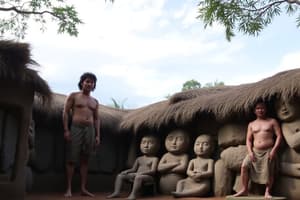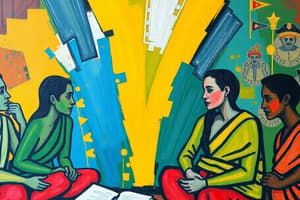Podcast
Questions and Answers
What is the importance of classifying Filipinos according to their social class?
What is the importance of classifying Filipinos according to their social class?
They were classified into social classes which served as a basis of their function and role in society, thus maintaining order in the community.
What is Baybayin?
What is Baybayin?
The system of writing they were able to develop before Spaniards arrived in the Philippines.
What is Animism?
What is Animism?
The kind of religion they were practicing during ancient times.
What significant event occurred in Sulu in 1280?
What significant event occurred in Sulu in 1280?
What was the first shelter for ancient Filipinos?
What was the first shelter for ancient Filipinos?
Why was there a need for farmers to leave their farms and return later?
Why was there a need for farmers to leave their farms and return later?
What is Batalan?
What is Batalan?
Match the social classes in Luzon and Visayas:
Match the social classes in Luzon and Visayas:
Who is William Henry Scott?
Who is William Henry Scott?
What were the qualifications in choosing a leader among early Filipinos?
What were the qualifications in choosing a leader among early Filipinos?
How was bravery measured in Cagayan?
How was bravery measured in Cagayan?
How can bravery be measured in Tagalog and Visayan cultures?
How can bravery be measured in Tagalog and Visayan cultures?
What is a Datu?
What is a Datu?
How was a Datu's wealth measured?
How was a Datu's wealth measured?
What does Maginoo refer to?
What does Maginoo refer to?
What is Maharlika?
What is Maharlika?
What are Bayani or heroes in Tagalog?
What are Bayani or heroes in Tagalog?
How did they honor their heroes?
How did they honor their heroes?
What were trademarks of warriors in Visayan culture?
What were trademarks of warriors in Visayan culture?
What does Timawa refer to?
What does Timawa refer to?
What were the duties of Timawa?
What were the duties of Timawa?
What is the lowest class in ancient Filipino society?
What is the lowest class in ancient Filipino society?
What is Alipin in Tagalog?
What is Alipin in Tagalog?
What is Oripun in Visayans?
What is Oripun in Visayans?
What are the three kinds of slaves in Visayans?
What are the three kinds of slaves in Visayans?
What are the characteristics of Ayuey?
What are the characteristics of Ayuey?
What does Tumarampuk imply?
What does Tumarampuk imply?
What is Tumataban?
What is Tumataban?
What were the two types of slaves in Tagalog?
What were the two types of slaves in Tagalog?
What defines Aliping Namamahay?
What defines Aliping Namamahay?
What are the characteristics of Aliping Saguiguilid?
What are the characteristics of Aliping Saguiguilid?
What circumstances could lead to someone becoming a slave?
What circumstances could lead to someone becoming a slave?
What is the difference between slaves in ancient Filipino culture and slaves in Western culture?
What is the difference between slaves in ancient Filipino culture and slaves in Western culture?
What is a tael?
What is a tael?
How many taels of gold were required for the freedom of a slave?
How many taels of gold were required for the freedom of a slave?
Flashcards are hidden until you start studying
Study Notes
Importance of Social Classification
- Social classes structured roles and functions in ancient Filipino communities, ensuring order and organization.
Writing System: Baybayin
- A pre-colonial script developed before Spanish colonization.
Religious Beliefs: Animism
- The ancient Filipinos practiced animism, a belief system attributing spiritual essence to objects and nature.
Spread of Islam
- In 1280, Islam began to spread in the Sulu region.
Early Shelter: Caves
- Caves served as the initial shelters for ancient Filipinos, providing protection from wildlife and adverse weather conditions.
Agricultural Practices
- Farmers vacated unsuitable land to allow it to rejuvenate, returning later for cultivation.
Batalan
- A space connected to the kitchen for washing dishes and storing cooking utensils.
Social Classes in Luzon and Visayas
- Highest Class: Tagalog - Maginoo, Visayas - Datu
- Second Class: Tagalog - Maharlika, Visayans - Timawa
- Bottom Class: Alipin
Social Hierarchy Acknowledgment
- William Henry Scott noted a social hierarchy among Tagalogs and Visayans, organizing society into classes.
Leadership Qualifications
- Bravery and wealth were crucial qualifications for leaders among early Filipinos.
Measuring Bravery in Cagayan
- Bravery was gauged by the number of enemies one had defeated, specifically through beheading.
Trading and Bravery
- Participation in trade signified bravery, as it involved facing sea dangers, wild animals, and other ethnic groups, contributing to wealth and governance.
Role of Datu
- Datu acted as community leaders who resolved disputes, protected their people, and led during conflicts.
Wealth Measurement of Datu
- Wealth was assessed not just by the number of slaves but by the quality and quantity of gold owned.
Maginoo Class
- Represented the noble class in society.
Maharlika Class
- Comprised warriors who defended barangays and maintained peace, free from tribute obligations to the datu.
Honor for Heroes
- Celebrations were organized to honor military leaders, marked by crowning ceremonies with gold-covered carabao horns.
Warrior Identification
- Visayan warriors adorned with tattoos indicated their bravery; Tagalog warriors wore a red putong as a mark of distinction.
Timawa Class
- Free individuals paying tribute to the datu engaged in various economic activities such as farming and trading.
Duties of Timawa
- Assisted the datu with agricultural work, accompanied him in expeditions, and helped during festivities, while maintaining the right to choose their datu.
Alipin Class
- Represented the lowest societal tier, encompassing slaves.
Terminology for Slaves
- In Tagalog: Alipin; in Visayan: Oripun.
Types of Visayan Slaves
- Ayuey: Least privileged, summoned at any time by the datu.
- Tumarampuk: Worked for a single day, could substitute rice for service.
- Tumataban: Occasional slaves, minimal duties.
Tagalog Slave Categories
- Aliping Namamahay: Lived separately, provided tributes, and assisted the datu.
- Aliping Saguiguilid: Resided with the datu, provided perpetual service without salary.
Path to Slavery
- Factors leading to slavery include theft, inability to pay debts, and wartime capture.
Differences in Slavery
- Ancient Filipino slaves were often treated better compared to Western slaves, with rights to farm and acquire property.
Measurement of Gold
- Taels were the unit of measurement for gold.
Cost of Freedom for Slaves
- 18 taels of gold were required for a slave's freedom, equivalent to two slaves' worth.
Studying That Suits You
Use AI to generate personalized quizzes and flashcards to suit your learning preferences.




